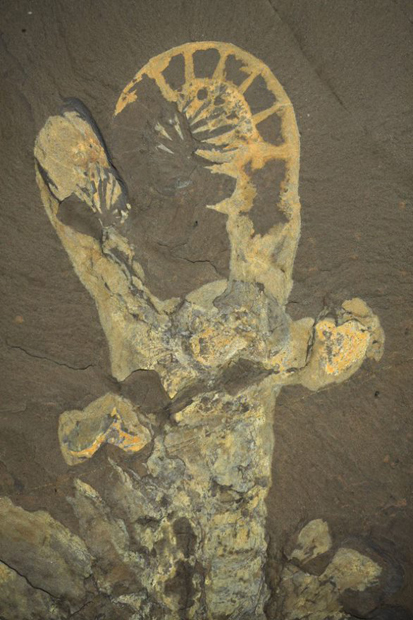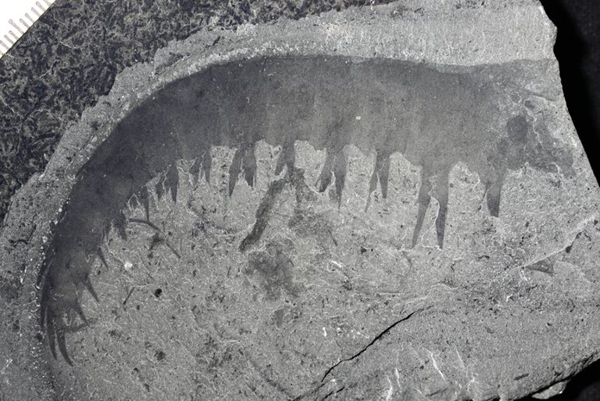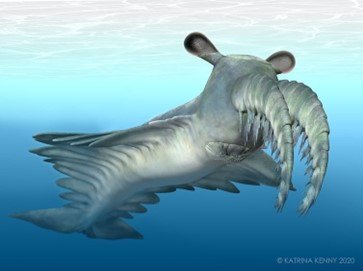A newly published study suggests that the Cambrian predator Anomalocaris canadensis had grasping appendages that were too weak to crack trilobite exoskeletons.
The research examined the mechanical properties of the claw-like appendages of the Late Cambrian predator Anomalocaris canadensis. The study concluded that this marine carnivore was built for speed but was not strong enough to crack the exoskeletons of trilobites.
A Nektonic, Agile Hunter
Writing in the academic journal the Proceedings of the Royal Society Biology, the researchers led by Russell Bicknell (American Museum of Natural History), show that A. canadensis was weaker than previously thought. They postulate that Anomalocaris was a fast and agile swimmer. It was nektonic, catching soft prey such as jelly fish and early vertebrates in open water. The study further refutes the idea that this large predator hunted trilobites.

This Study Supports the Conclusions of Earlier Research
Earlier research (Christopher Nedin, 1999) focused on the ring-shaped mouthparts of Anomalocaris (the oral cone). Anomalocaris mouthparts were at first misidentified. The oral cone was once thought to represent a jellyfish and named Peytoia. The lack of wear on the mouthparts was highlighted suggesting that they did not they did not come into regular contact with mineralised trilobite exoskeletons. It was proposed these radiodonts probably fed on soft-bodied organisms.
Revising the Behaviour of Anomalocaris canadensis
It had been thought that Anomalocaris was responsible for some of the scarred and crushed trilobite specimens preserved in the fossil record.
Postdoctoral researcher Russell Bicknell commented:
“That didn’t sit right with me because trilobites have a very strong exoskeleton, which they essentially make out of rock, while this animal would have been mostly soft and squishy.”
Picture credit: Everything Dinosaur
The illustration (above) is based on the recently introduced CollectA Anomalocaris replica.
To view this model range: CollectA Prehistoric Life Figures.
Examining the Grasping Appendages
This study set out to investigate whether the pair of grasping appendages located on the head were capable of ripping apart a trilobite. Burgess Shale fossil material was used to create an accurate three-dimensional model of Anomalocaris canadensis.
Natural History Museum researcher and co-author of the paper, Greg Edgecombe explained:
“Having access to specimens with the entire body preserved in the fossils allowed us to understand the anatomy of the appendages in the context of the rest of the head and the trunk. We were able to get a better picture of Anomalocaris as a living organism.”

Compared to Extant Whip Scorpions and Whip Spiders
The scientists used modern predatory whip spiders and whip scorpions as analogues. The team demonstrated that the predator’s segmented appendages were able to grab prey and could both stretch and flex. Finite element analysis, a modelling technique used in engineering, was used to identify stresses and points where the appendage would have been under strain.
The team calculated that the appendages would have been damaged while grasping hard prey such as trilobites. The researchers also used computational fluid dynamics to place the three-dimensional model of Anomalocaris in a virtual current to predict the body position it would use while swimming.
Dr Imran Rahman (London Natural History Museum) stated:
“This study emphasises the great potential of modern computer modelling methods in palaeontology. By employing techniques more commonly used in other disciplines like engineering, we can test ideas about long-extinct animals like Anomalocaris.”
This is the first time this combination of biomechanical modelling techniques has been used together in a single study. A different view of Anomalocaris canadensis has emerged. The animal was probably nektonic. A speedy swimmer, chasing soft-bodied prey in the water column with its front appendages outstretched and forward-facing.
Bicknell remarked:
“Previous conceptions were that these animals would have seen the Burgess Shale fauna as a smorgasbord, going after anything they wanted to, but we are finding that the dynamics of the Cambrian food webs were probably much more complex that we once thought.”
Everything Dinosaur acknowledges the assistance of a media release from the London Natural History Museum in the compilation of this article.
The scientific paper: “Raptorial appendages of the Cambrian apex predator Anomalocaris canadensis are built for soft prey and speed” by Russell D. C. Bicknell, Michel Schmidt, Imran A. Rahman, Gregory D. Edgecombe, Susana Gutarra, Allison C. Daley, Roland R. Melzer, Stephen Wroe and John R. Paterson published in the Proceedings of the Royal Society B.








Leave A Comment